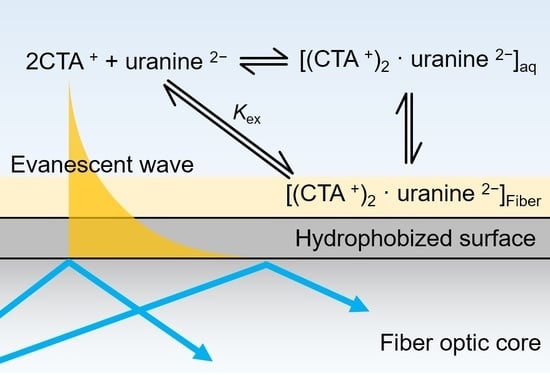Evanescent-Wave Fiber Optic Sensing of the Anionic Dye Uranine Based on Ion Association Extraction
Abstract
1. Introduction
2. Material and Methods
3. Results and Discussion
3.1. Optimization of CATB Concentration
3.2. Distribution Equilibrium Model
Kf = [(CTA+)2 · uranine2−]aq / [CTA+]2 [uranine2−]
{(CTA+)2 · uranine2−}aq ⇌ {(CTA+)2 · uranine2−}fiber ;
3.3. Adsorption Model
3.4. Regeneration of the Fiber Sensor
3.5. Determination of Uranine
4. Conclusions
Supplementary Materials
Author Contributions
Funding
Conflicts of Interest
References
- Wolfbeis, O.S. Fiber-Optic Chemical Sensors and Biosensors. Anal. Chem. 2004, 76, 3269–3284. [Google Scholar] [CrossRef]
- McDonagh, C.; Burke, C.S.; MacCraith, B.D. Optical Chemical Sensors. Chem. Rev. 2008, 108, 400–422. [Google Scholar] [CrossRef]
- Wang, X.-D.; Wolfbeis, O.S. Fiber-Optic Chemical Sensors and Biosensors (2008–2012). Anal. Chem. 2013, 85, 487–508. [Google Scholar] [CrossRef]
- Wang, X.; Wolfbeis, O.S. Fiber-Optic Chemical Sensors and Biosensors (2013–2015). Anal. Chem. 2016, 88, 203–227. [Google Scholar] [CrossRef]
- Wang, X.; Wolfbeis, O.S. Fiber-Optic Chemical Sensors and Biosensors (2015–2019). Anal. Chem. 2020, 92, 397–430. [Google Scholar] [CrossRef]
- Qazi, H.; Mohammad, A.; Akram, M. Recent Progress in Optical Chemical Sensors. Sensors 2012, 12, 16522–16556. [Google Scholar] [CrossRef]
- Punjabi, N.; Satija, J.; Mukherji, S. Evanescent Wave Absorption Based Fiber-Optic Sensor—Cascading of Bend and Tapered Geometry for Enhanced Sensitivity. In Smart Sensors, Measurement and Instrumentation; Springer: Cham, Switzerland, 2015; pp. 25–45. [Google Scholar]
- Yeh, T.-S.; Chu, C.-S.; Lo, Y.-L. Highly sensitive optical fiber oxygen sensor using Pt(II) complex embedded in sol–gel matrices. Sensors Actuators B Chem. 2006, 119, 701–707. [Google Scholar] [CrossRef]
- Dong, S.; Luo, M.; Peng, G.; Cheng, W. Broad range pH sensor based on sol-gel entrapped indicators on fibre optic. Sensors Actuators B Chem. 2008, 129, 94–98. [Google Scholar] [CrossRef]
- Xiong, Y.; Zhu, D.Q.; Duan, C.F.; Wang, J.W.; Guan, Y.F. Small-volume fiber-optic evanescent-wave absorption sensor for nitrite determination. Anal. Bioanal. Chem. 2010, 396, 943–948. [Google Scholar] [CrossRef]
- Balan Pillai, A.; Varghese, B.; Madhusoodanan, K.N. Design and development of novel sensors for the determination of fluoride in water. Environ. Sci. Technol. 2012, 46, 404–409. [Google Scholar] [CrossRef]
- Qiu, Y.; Tang, Y.; Li, B.; Gu, C.; He, M. Aptamer-based detection of melamine in milk using an evanescent wave fiber sensor. Anal. Methods 2018, 10, 4871–4878. [Google Scholar] [CrossRef]
- Long, F.; Wu, S.; He, M.; Tong, T.; Shi, H. Ultrasensitive quantum dots-based DNA detection and hybridization kinetics analysis with evanescent wave biosensing platform. Biosens. Bioelectron. 2011, 26, 2390–2395. [Google Scholar] [CrossRef]
- Bharadwaj, R.; Sai, V.V.R.; Thakare, K.; Dhawangale, A.; Kundu, T.; Titus, S.; Verma, P.K.; Mukherji, S. Evanescent wave absorbance based fiber optic biosensor for label-free detection of E. coli at 280nm wavelength. Biosens. Bioelectron. 2011, 26, 3367–3370. [Google Scholar] [CrossRef]
- Okazaki, T.; Imai, K.; Tan, S.Y.; Yong, Y.T.; Rahman, F.A.; Hata, N.; Taguchi, S.; Ueda, A.; Kuramitz, H. Fundamental Study on the Development of Fiber Optic Sensor for Real-time Sensing of CaCO3 Scale Formation in Geothermal Water. Anal. Sci. 2015, 31, 177–183. [Google Scholar] [CrossRef]
- Okazaki, T.; Orii, T.; Ueda, A.; Ozawa, A.; Kuramitz, H. Fiber Optic Sensor for Real-Time Sensing of Silica Scale Formation in Geothermal Water. Sci. Rep. 2017, 7, 3387. [Google Scholar] [CrossRef]
- Imai, K.; Okazaki, T.; Hata, N.; Taguchi, S.; Sugawara, K.; Kuramitz, H. Simultaneous multiselective spectroelectrochemical fiber-optic sensor: Demonstration of the concept using methylene blue and ferrocyanide. Anal. Chem. 2015, 87, 2375–2382. [Google Scholar] [CrossRef]
- Okazaki, T.; Shiokawa, E.; Orii, T.; Yamamoto, T.; Hata, N.; Taguchi, A.; Sugawara, K.; Kuramitz, H. Simultaneous Multiselective Spectroelectrochemical Fiber-Optic Sensor: Sensing with an Optically Transparent Electrode. Anal. Chem. 2018, 90, 2440–2445. [Google Scholar] [CrossRef]
- Okazaki, T.; Imai, K.; Sultana, A.; Hata, N.; Taguchi, S.; Kuramitz, H. Development of a Fiber Optic Evanescent Wave Sensor for Anionic Surfactants Using Ethyl Violet. Anal. Lett. 2015, 48, 2217–2222. [Google Scholar] [CrossRef]
- Toei, K. Ion-association reagents. A review. Anal. Sci. 1987, 3, 479–488. [Google Scholar] [CrossRef]
- Watarai, H. Fundamentals in Solvent Extraction Processes, Thermodynamic, Kinetic, and Interfacial Aspects. In Solvent Extraction and Liquid Membranes; Aguilar, M., Cortina, J.L., Eds.; CRC Press: Boca Raton, FL, USA, 2008; pp. 19–57. [Google Scholar]
- Japanese Industrial Standards Committee. Japanese Indutrial Standards K0102; Japanese Industrial Standards Committee: Tokyo, Japan, 2019. [Google Scholar]
- Mushahida-AL-Noor, S.; Murashima, R.; Okazaki, T.; Taguchi, S.; Kuramitz, H.; Hata, N. Micro-organic Ion-associate Phase Extraction/micro-volume Back-extraction for the Preconcentration and GF-AAS Determination of Cadmium, Nickel and Lead in Environmental Water. Anal. Sci. 2018, 34, 1445–1448. [Google Scholar] [CrossRef]
- Hata, N.; Yuwatini, E.; Ando, K.; Yamada, M.; Kasahara, I.; Taguchi, S. Micro-organic Ion-associate Phase Extraction via in situ Fresh Phase Formation for the Preconcentration and Determination of Di(2-ethylhexyl)phthalate in River Water by HPLC. Anal. Sci. 2004, 20, 149–152. [Google Scholar] [CrossRef][Green Version]
- Hata, N.; Kasahara, I.; Taguchi, S. Micro-phase Sorbent Extraction for Trace Analysis via in situ Sorbent Formation: Application to the Preconcentration and the Spectrophotometric Determination of Trace Ammonia. Anal. Sci. 2002, 18, 697–699. [Google Scholar] [CrossRef][Green Version]
- Taguchi, S.; Nakayama, K.; Hata, N.; Kasahara, I.; Goto, K. Membrane filters for concentration of trace elements in water: Distribution of 2-(2-pyridylazo)-5-diethylaminophenol between the membrane filter and the aqueous phases. Analyst 1994, 119, 135. [Google Scholar] [CrossRef]
- Ito, A.; Fujimoto, N.; Okamoto, T.; Ando, Y.; Watanabe, H. Tumorigenicity study of phloxine (FR 104) in B6C3F1 mice. Food Chem. Toxicol. 1994, 32, 517–520. [Google Scholar] [CrossRef]
- Alcantara-Licudine, J.P.; Kawate, M.K.; Li, Q.X. Method for the Analysis of Phloxine B, Uranine, and Related Xanthene Dyes in Soil Using Supercritical Fluid Extraction and High-Performance Liquid Chromatography. J. Agric. Food Chem. 1997, 45, 766–773. [Google Scholar] [CrossRef]
- Licudine, J.A.; McQuate, G.T.; Cunningham, R.T.; Liquido, N.J.; Li, Q.X. Efficacy and residues of phloxine B and uranine for the suppression of Mediterranean fruit fly in coffee fields. Pest Manag. Sci. 2002, 58, 38–44. [Google Scholar] [CrossRef]
- Carpenter, T.L.; Mundie, T.G.; Ross, J.H.; Heitz, J.R. Synergistic Effect of Fluorescein on Rose Bengal-Induced, Light-Dependent Toxicity. Environ. Entomol. 1981, 10, 953–955. [Google Scholar] [CrossRef]
- Stober, I.; Bucher, K. Geothermal Energy; Springer: Berlin/Heidelberg, Germany, 2013. [Google Scholar]
- Foguel, M.V.; Ton, X.-A.; Zanoni, M.V.B.; Sotomayor, M.D.P.T.; Haupt, K.; Tse Sum Bui, B. A molecularly imprinted polymer-based evanescent wave fiber optic sensor for the detection of basic red 9 dye. Sensors Actuators B Chem. 2015, 218, 222–228. [Google Scholar] [CrossRef]
- Schulz, S.; Maitz, M.; Hänsel, S.; Renner, L.D.; Werner, C. Analyzing the antiseptic capacity of silver-functionalized poly(ethylene glycol)–heparin hydrogels after human whole blood exposure. Biomater. Sci. 2018, 6, 1129–1139. [Google Scholar] [CrossRef]
- Product Information. Available online: https://www.sigmaaldrich.com/content/dam/sigma-aldrich/docs/Sigma/Product_Information_Sheet/1/sl2pis.pdf (accessed on 18 January 2020).
- De Sá, A.; Abreu, A.S.; Moura, I.; Machado, A.V. Polymeric materials for metal sorption from hydric resources. In Water Purification; Elsevier: Amsterdam, The Netherlands, 2017; pp. 289–322. [Google Scholar]
- Mahmoud, A.M.; Tang, T.; Jed Harrison, D.; Lee, W.E.; Jemere, A.B. A regenerating self-assembled gold nanoparticle-containing electrochemical impedance sensor. Biosens. Bioelectron. 2014, 56, 328–333. [Google Scholar] [CrossRef]
- FT200EMT Spec Sheet. Available online: https://www.thorlabs.co.jp/drawings/ae728e64c3999cfd-3FE1C16E-BAFF-B1B0-9E0155A9277DFD9E/FT200EMT-SpecSheet.pdf (accessed on 18 January 2020).
- Okazaki, T.; Seto, R.; Watanabe, T.; Ueda, A.; Kuramitz, H. U-Shaped Polymer Cladding and Hetero-Core Fiber Optic Sensors for Monitoring Scale Formation in Geothermal Brine. Anal. Lett. 2020. [Google Scholar] [CrossRef]

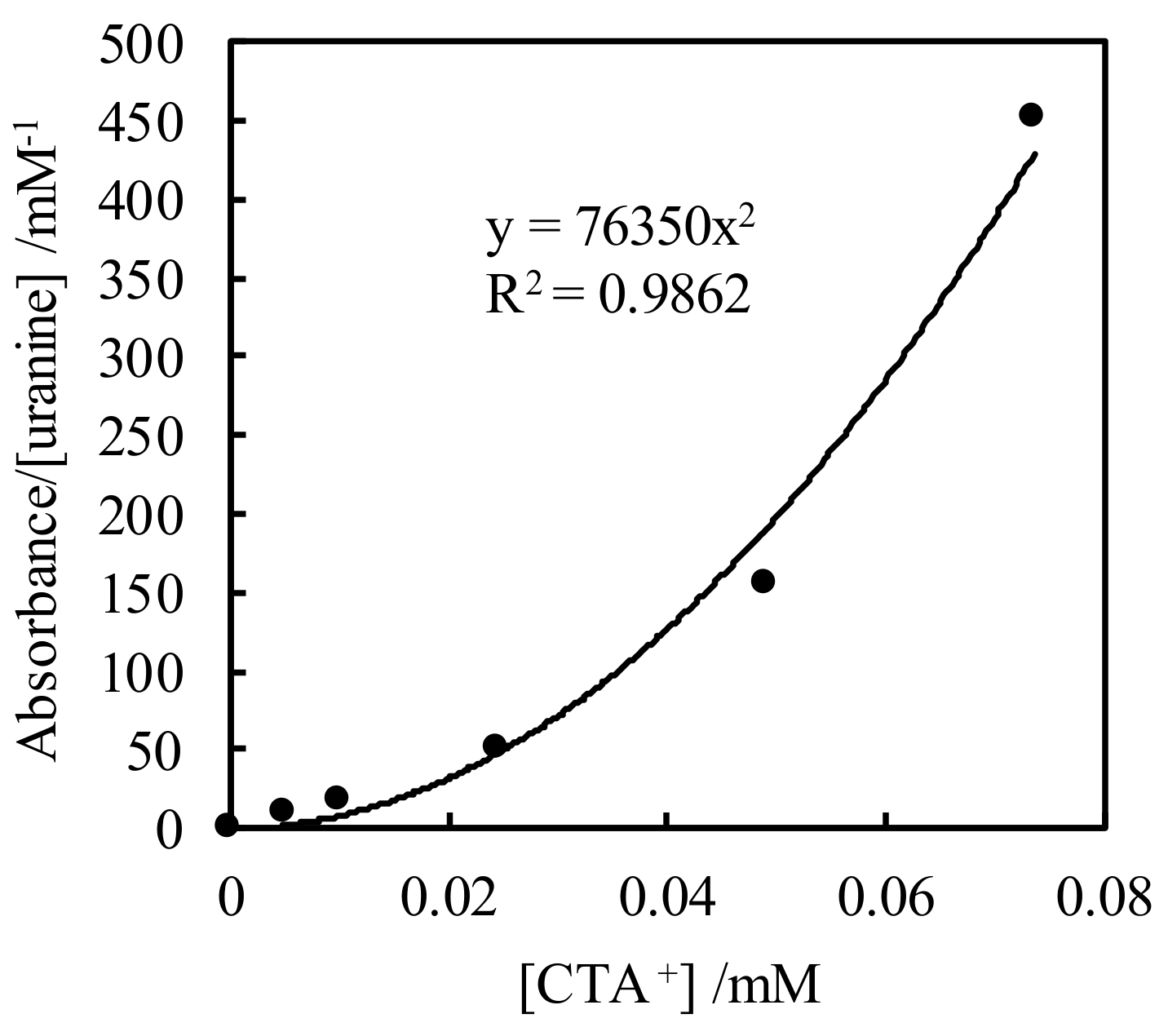
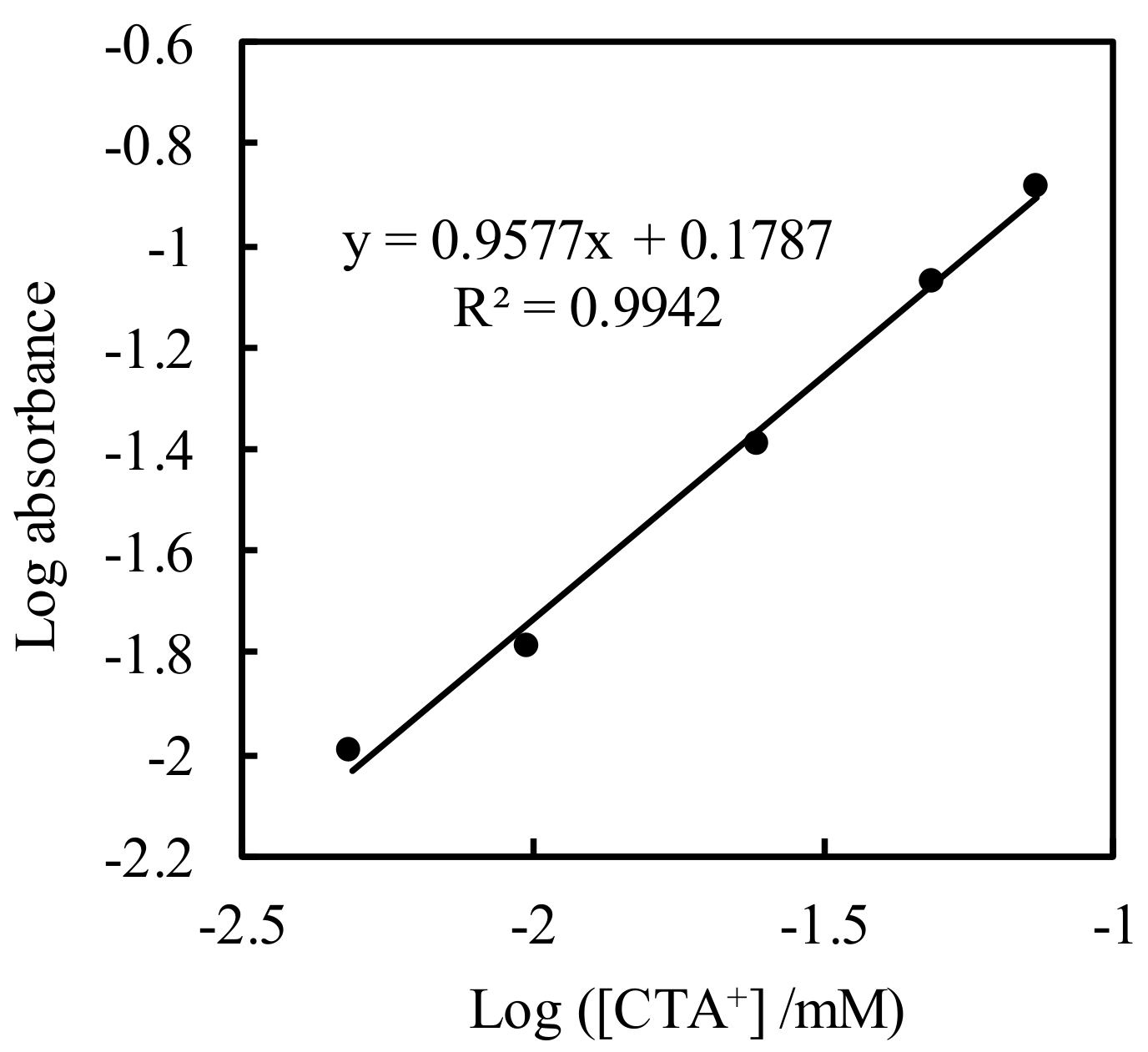
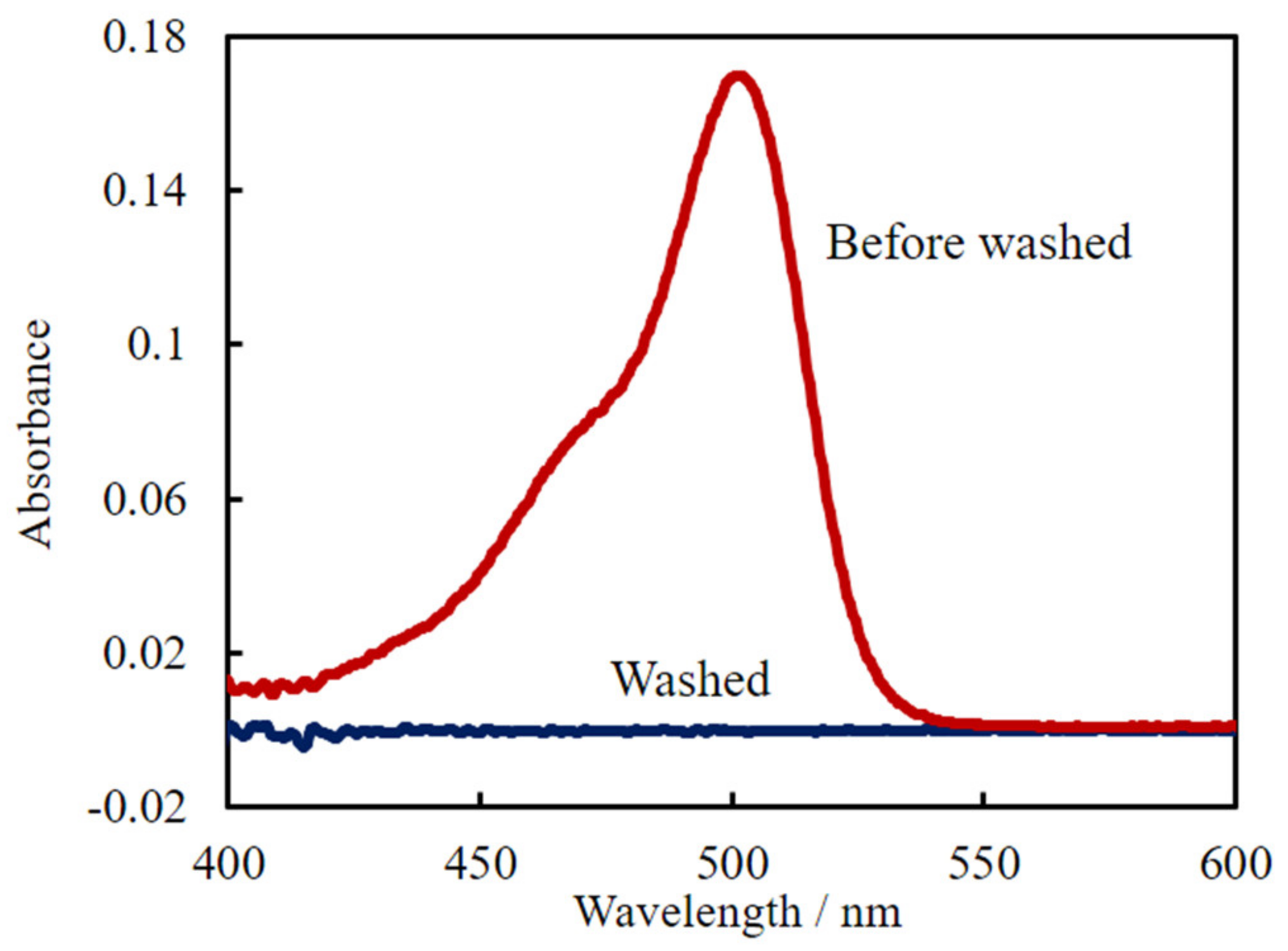
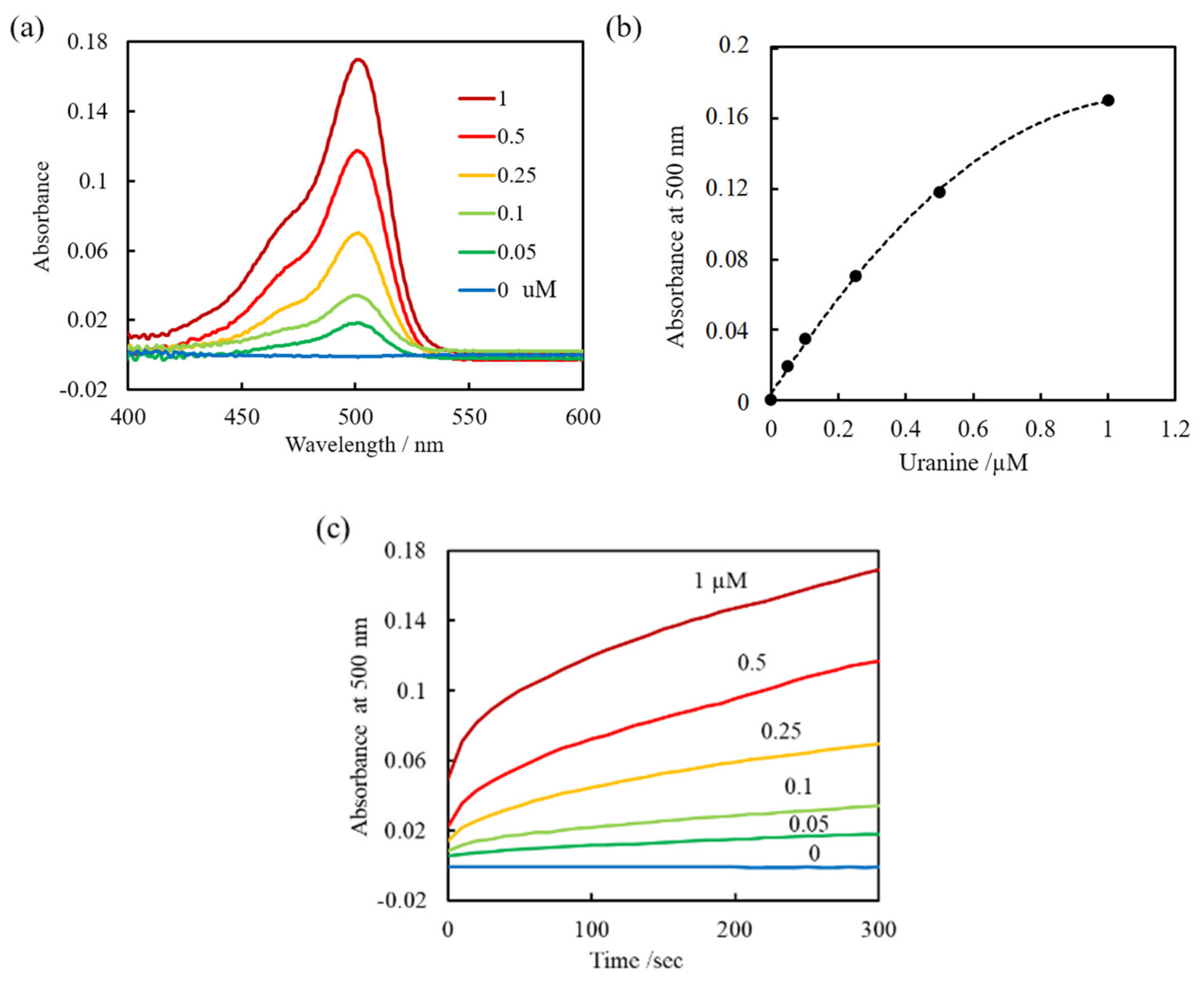
© 2020 by the authors. Licensee MDPI, Basel, Switzerland. This article is an open access article distributed under the terms and conditions of the Creative Commons Attribution (CC BY) license (http://creativecommons.org/licenses/by/4.0/).
Share and Cite
Okazaki, T.; Watanabe, T.; Kuramitz, H. Evanescent-Wave Fiber Optic Sensing of the Anionic Dye Uranine Based on Ion Association Extraction. Sensors 2020, 20, 2796. https://doi.org/10.3390/s20102796
Okazaki T, Watanabe T, Kuramitz H. Evanescent-Wave Fiber Optic Sensing of the Anionic Dye Uranine Based on Ion Association Extraction. Sensors. 2020; 20(10):2796. https://doi.org/10.3390/s20102796
Chicago/Turabian StyleOkazaki, Takuya, Tomoaki Watanabe, and Hideki Kuramitz. 2020. "Evanescent-Wave Fiber Optic Sensing of the Anionic Dye Uranine Based on Ion Association Extraction" Sensors 20, no. 10: 2796. https://doi.org/10.3390/s20102796
APA StyleOkazaki, T., Watanabe, T., & Kuramitz, H. (2020). Evanescent-Wave Fiber Optic Sensing of the Anionic Dye Uranine Based on Ion Association Extraction. Sensors, 20(10), 2796. https://doi.org/10.3390/s20102796




